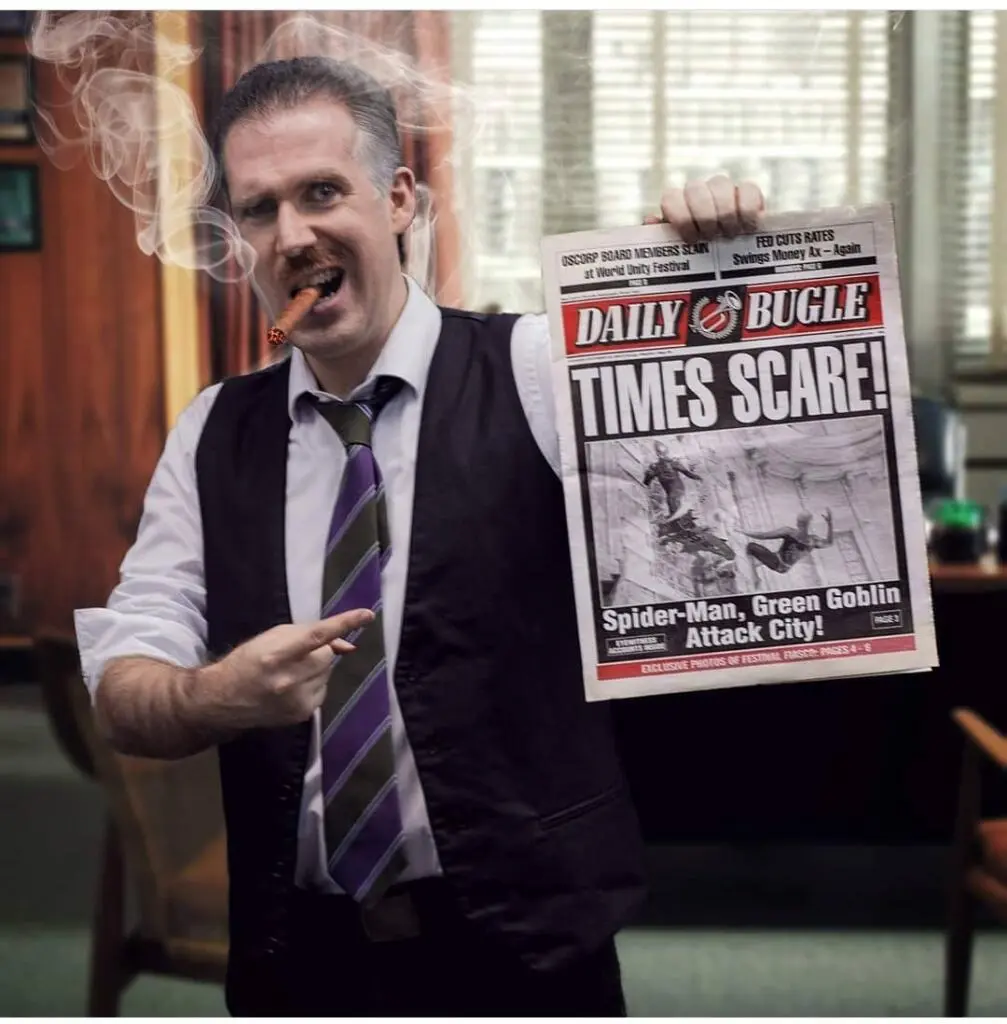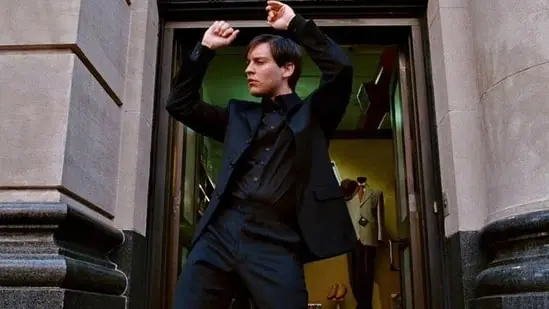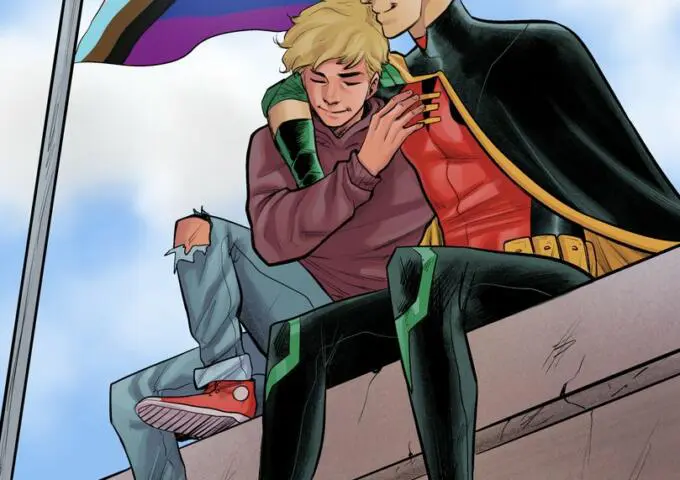Back in 1962, Stan Lee and Steve Ditko graced the world with their latest creation: Spider-Man. The story of a teen from Queens who unexpectedly gains spider-themed powers became an instant classic with the relatable struggles of Peter Parker trying to balance his double life.
While Spider-Man stories have gotten cosmically complex in the last 60 years, with multiversal events and world-shattering retcons, one thing remains the same: we can all relate to Spider-Man in some way or another.
With it being Pride Month, the release of the sublime Spider-Man: Across the Spider-Verse, and the discourse around Spider-Gwen’s bedroom decor, it feels like the perfect time to look at the Spider-People and their world as an allegory for Queerness.
[Spoilers for Spider-Man: Across the Spider-Verse and some Spider-Man comics]
Okay, Let’s Do This One Last Time…
Who is Spider-Man? That question is more complex than you might think, but here are some of the basics of the character and some nerdy terminology that will help keep things swinging smoothly.
In the Marvel Comics multiverse, the main continuity is known as Earth-616. This is where we first meet Peter Parker, a nerdy and brilliant high school student from working-class Queens, New York who lives with his elderly Aunt May and Uncle Ben.
During a school trip, Peter is bitten by a radioactive spider and, instead of cancer, gets powers that include enhanced strength, agility, speed, durability, almost pre-cognitive reflexes, and wall-crawling. After inventing his own web shooters, Peter uses his gifts to make money by becoming a celebrity.
Too busy lining his own pockets to care, Peter lets a burglar run past him. That same criminal later shoots and kills dear old Uncle Ben, teaching Peter the foundational Spider-lesson of…
All together, now!
“With great power comes great responsibility.”
Since that night, Peter has struggled, and often failed, to balance his personal life with his heroic alter-ego as everyone’s favorite friendly neighborhood web-slinger.
We will dig deeper into other hallmarks of Spider-lore, but that is the absolute basics.
Since Spidey’s debut, things have gotten a tad bit more complicated with clones, the multiverse, aliens, and even Marvel-brand Satan.
Despite Peter’s real-world struggles and street-level scraps, Spider-Man has always ventured into comic book insanity head first. In fact, Spidey was traveling the multiverse going all the way back to the 1990s, almost 30 years before every movie and show became obsessed with the concept.
This malleability has allowed Spider-Man, and all variant Spider-Folks, to become a perfect vessel for allegory and social commentary.
This is especially true for the Queer experience.
Spider-Man: Into the Rainbow
Part of what made Stan Lee the legend that he is today was his ability to create relatable superheroes. That may not seem like much in 2023, but in the 1960s it was a revolutionary idea.
Most of us can’t see ourselves as a billionaire bat-furry, or a billionaire war profiteer wearing a robot suit, but all of us can connect to a kid just trying his best and coming up short. That concept hits harder if, like a Spider-Person, your struggles are invisible to people in your life.
Spider-Man and the stories in the Spider-Verse can be easily mapped to a myriad of issues and be analyzed through just as many lenses.
Peter is typically poor, so you can read it through the lens of class. Miles Morales, the half-Black half-Puerto Rican Spider-Man introduced in 2011, let us view web-slinging through the lens of race.
A personal favorite of mine is how Ol’ Web-Head can be used as an allegory for neurodivergence.
However, there are few allegories that hit as hard as the experience of being Queer.
The most obvious connection, and one that can be seen with other superheroes, is the idea of having a secret identity. The fact that you have to keep a major part of who you are a secret, even from your nearest and dearest, is a struggle many of us in the LGBTQ+ community can sympathize with.
Part of it is a matter of safety. Revealing your secret to the world can open you up to attack from media-driven panic or actual goblins.
Another is how your loved ones will react. Peter has, in most of the continuity, kept his crime-fighting a secret from Aunt May. Even though Pete knows that she loves him no matter what, he keeps it hidden to avoid stressing her out to the point of a heart attack.
Considering Aunt May’s age has ranged from a sexy 60 to 10,000 years old, it might be a good idea to play it safe here.
That being said, there have been plenty of “coming out” to Aunt May stories for 616-Peter. Many of them have May simply saying that she already knew and fully supports her adoptive son’s nightlife.
Moving through the multiverse we recently got a version of how this can go wrong on the big screen with Spider-Gwen in Spider-Man: Across the Spider-Verse.
Spider-Gwen, from a universe where Peter’s long-dead love Gwen Stacy was bitten by a radioactive spider instead, told her cop father about her wall-crawling secret and he pulled a gun on her.
One could say that since all Spider-People are illegal vigilantes, Cpt. Stacy was just doing his job and the analogy falls apart because being trans or queer isn’t a crime.
My answer would be, first of all, it isn’t illegal yet despite some states trying their hardest.
I would also say that regardless of legality, some people’s parents or families may react the same way thanks to decades of baseless and disgusting fearmongering. We even have elected officials who feel comfortable saying publicly that they would rather their kid die instead of transition.
Some of you may be seeing a connection to another Spider-staple already. Hold on to that so you can feel the rush of being right when I get to him later.
For Gwen, things work out in the end. Her dad decides to quit the force out of love for his daughter. Sadly, the same can’t be said for everyone.
The similarities don’t stop at revealing your true self to family and friends.
Consider how Peter behaves in and out of the suit. During the day, Parker is shy, nerdy, and quiet. When he slaps on the spandex, things change.
A hallmark of Spider-Man is the quips and jokes he cracks in deadly serious situations. He’s having fun confidently jumping around and saving the day. Peter becomes his idealized self when he’s wearing the mask.
An obvious connection is that accepting his true nature frees him from everyday worries and the sacrifices he makes to keep the world from finding out his secret.
Another way to look at is that this is a man dressing in a flamboyant, colorful, and sexy costume that brings out a personality to match.
You know, kind of like Drag?
The superhero community can also work as an allegory for queer folks finding their chosen family. Not only are teams like The Avengers, X-Men, or The Fantastic Four safe spaces for Spidey to hang because they respect him, but they are the only people who he can open up about his double life.
No matter how much support you can get from allies like friends and family, there is something special about being in a room full of people who truly get it.
Safe spaces are spectacular, but they can be few and far between. Moving through modern America as a queer person, especially if you are trans or non-bi, requires almost constant vigilance to avoid danger.
That danger could just be some jackass yelling something and ruining the vibe, or it could be a real physical threat. Either way, you have to stay alert.
You have to develop a spidey-sense.
Unlike Spider-Man, you probably don’t need to worry about Doc Ock, Kraven, or any other outlandish villains from the funny pages.
There is one antagonist all of the Spiders share, and he is the closest thing we have to some villains in our world.
Spider-Man is a Menace!
It is finally time to talk about J. Jonah Jameson and outrage culture.
J. Jonah is a newsman, through and through. Most people know him as the Editor-in-Chief of The Daily Bugle, a successful and respected paper in Marvel’s New York, that was played to absolute perfection by J.K. Simmons in Sam Raimi’s trilogy and now the MCU.
Jameson hates Spider-Man. Just straight-up hates him. No matter how many times Spider-Man saves the city, Jameson will not admit that he was wrong and stop plastering lie-filled hit pieces on the front page.
There is no evidence for anything Jameson says about Spider-Man being a dangerous criminal, but he has dined out on that hatred for decades. J. Jonah has done more than just write about his distrust of Spider-Man. He’s funded mad science projects that created villains like The Scorpion and the Spider-Slayers.
I’m sure there is nothing about a powerful media personality profiting from spreading fear and hatred through lies that leads to violence that sounds like our world, right?
The irony through all of Jameson’s targeted attacks is that he relies on Peter to bring him pictures of Spider-Man. While JJJ is frothing at the mouth over his distrust and hatred of Spidey, he respects and trusts Peter.
This dynamic maps pretty neatly to the experience of most queer people who have casual relationships with others who feel comfortable saying homophobic or transphobic things because they assume everyone agrees with them.
That dynamic can shift dramatically when they learn the truth.
Peter’s identity has been revealed before and then retconned, with the most recent reveal to J Jonah being the most fascinating.
In the current 616 continuity, J Jonah has had a bit of a fall from grace. He was forced to sell his paper, was mayor for a brief stint, and now runs his own blog. After decades of anti-Spidey sentiment, the two sit down for an interview that goes from combative to heartbreaking to cathartic when Peter finally takes off his mask.
Spider-Man grills JJJ about where all of this hate comes from. Jameson goes through the usual list of grievances, mostly about how a masked man is always suspicious and supervillain escalation, but we do eventually drill down to the heart of the matter.
Jameson has lost his wife, his son, and his paper. Hate is all he has left.
This vulnerable admission is reminiscent of the thousands of Q-Anon fanatics and MAGA chuds. Many of these people report being isolated from their friends and families, leaving them only with this world of made-up threats and swelling rage.
Also, like in real life, after Jameson puts a familiar face to what he sees as a threat, he steps back from his warrior’s keyboard and becomes a stalwart ally to the Wall-Crawler.
Several studies have shown that personal prejudices and bigotry are most effectively undone when the bigot in question actually meets someone from the community they’ve targeted.
Think of the classic scenario of an anti-gay senator or preacher walking back the fire and brimstone when one of their own children comes out of the closet.
It’s like that but with more spandex.
That doesn’t mean that there isn’t still a large contingent of citizens who despise Spider-Man, but it’s a start.
J. Jonah Jameson’s anti-Spidey rhetoric is an excellent allegory for how major and independent news media can manipulate facts or simply make some shit up to enable a money-making machine that is fueled by hate and how changing one person’s mind is not enough to turn the machine off.
For that, we would need massive cultural change or even buck our idea of what our culture is.
Speaking of which…
Canon Fodder
This was mentioned above, but I want to reiterate that there will be major spoilers for Spider-Man: Across the Spider-Verse.
Okay, now let’s talk about Miles Morales and the idea behind “Canon”.
Canon is more or less another way of saying tradition, lore, continuity, or conventions. In multiversal superhero media terms, this means that every version of a character shares certain pivitol events in their timeline. This concept is especially important to the Spider-Verse.
We’ll dive into greater detail about the conventions of a Spider-Person in a second, but first, we have to look at how Miles deals with the idea of having a set narrative chosen for him.
In the first Spider-Verse film, we meet Miles as a kid from Brooklyn who gets powers and almost immediately witness the death of his world’s Peter. We meet a variety of other Spider-People and Miles learns from them and their shared experiences to eventually save the day and become this world’s one and only Spider-Man.
In the comics, it was a much longer road for Miles to feel accepted.
Besides the real-world tantrum racist fans through over a new and non-white Spidey, the heroes of Mile’s Earth (Earth-1610) took issue with Miles wearing the mask so soon after Peter’s passing.
In 2023’s Across the Spider-Verse, we learn that Miles is an anomaly and was never meant to be Spider-Man. This revelation is happening in the midst of Miles’ teenage angst about what everyone expects from him and how he should live his life.
Miles is told over and over that his existence breaks conventional canon and he needs to get in line.
Reality has its own canon that comes from skewed history and societal conventions. According to American canon, the “normal” or “correct” lifestyle is one that adheres to white, Christian, heteronormative, capitalist, gender conventions.
Like the panic that surrounds it, queerness and changing gender expression are nothing new. People have been swinging around the gender and sexuality spectrum since the beginning of humanity.
The canon developed in the United States is that people who don’t fit neatly into the prescribed categories are an anomaly that needs to be corrected, not celebrated.
Sadly, this issue isn’t the sole province of right-wing conservatism.
Even within queer communities, there are exclusionary attitudes and behavior. Some gay people don’t think being Bi or Pansexual counts. Some queer people are told they aren’t queer enough because they don’t fit a stereotypical idea of queerness.
Believe it or not, there are queer spaces that don’t want to include trans people.
No matter where you fall as a queer person, you are going to mess with someone’s canon. Even if you do everything they tell you, your mere existence is a problem for them.
Canon is another way of saying things are what they are because that’s how it has always been.
Miles makes the decision to tell canon to eat a fat one and make his own decisions. This is obviously not an easy decision and requires him to fight his way through thousands of fellow Spider-People, but it is the right choice for him.
Being part of the LGBTQ+ community means having to choose how your own story is told, canon be damned.
There is one more aspect of Spider-Canon that, at least to me, hits way harder than that.
Keep Your Web-Head Held High
People don’t often think of Spider-Man as a tragic character. At least not like Batman, who lost his parents as a child.
According to Spider-Canon, Spider-Man needs to witness the death of at least one parental figure, one ally, one serious partner, and generally needs to lose every personal battle while alienating friends and family.
Not only does this further prove Batman is a drama queen who needs therapy, but it says volumes about the queer experience. Based on his life, Spider-Man should be brooding, grim, and sullen but is far from that. He’s funny, joyful, and often tries to help the same people who mean him harm.
He’s your friendly neighborhood Spider-Man.
With ever-increasing hate thrown at LGBTQ+ people, there is an assumption that being queer is miserable even among well-intentioned straights. How many of us have heard someone say the only reason they wouldn’t want a queer kid is because they don’t want them to be a target?
What gets left out of news media and award-winning prestige dramas is how much joy there is in the queer community.
Like, have you seen our flags? Shit, most of us are just called “gay”, meaning happy and joyful.
Spider-Man does have his dark moments (looking at you, Bully Maguire), but all Spider-People deal with trauma on the daily and just keep quipping and swinging.
Spider-Man gets his ass handed to him over and over and then reads supervillains to filth.
To say being queer in America can be extremely difficult is one hell of an understatement, but rising above it all and living a happy, full life is not something you can only read about in comic books.
‘Nuff Said
America in 2023 is full of goblins, craven hunters, and venom for queer people and that can make it hard to live your best life.
Spider-Man and the web of diverse stories told across the Spider-Verse are spectacular when seen through a queer lens. The relatability and resilience of the character can provide comfort and inspiration, no matter how old you are or where you find yourself on the rainbow.
Anyone of us could be like Spider-Man, anyone can wear the mask with pride.







Leave a Reply